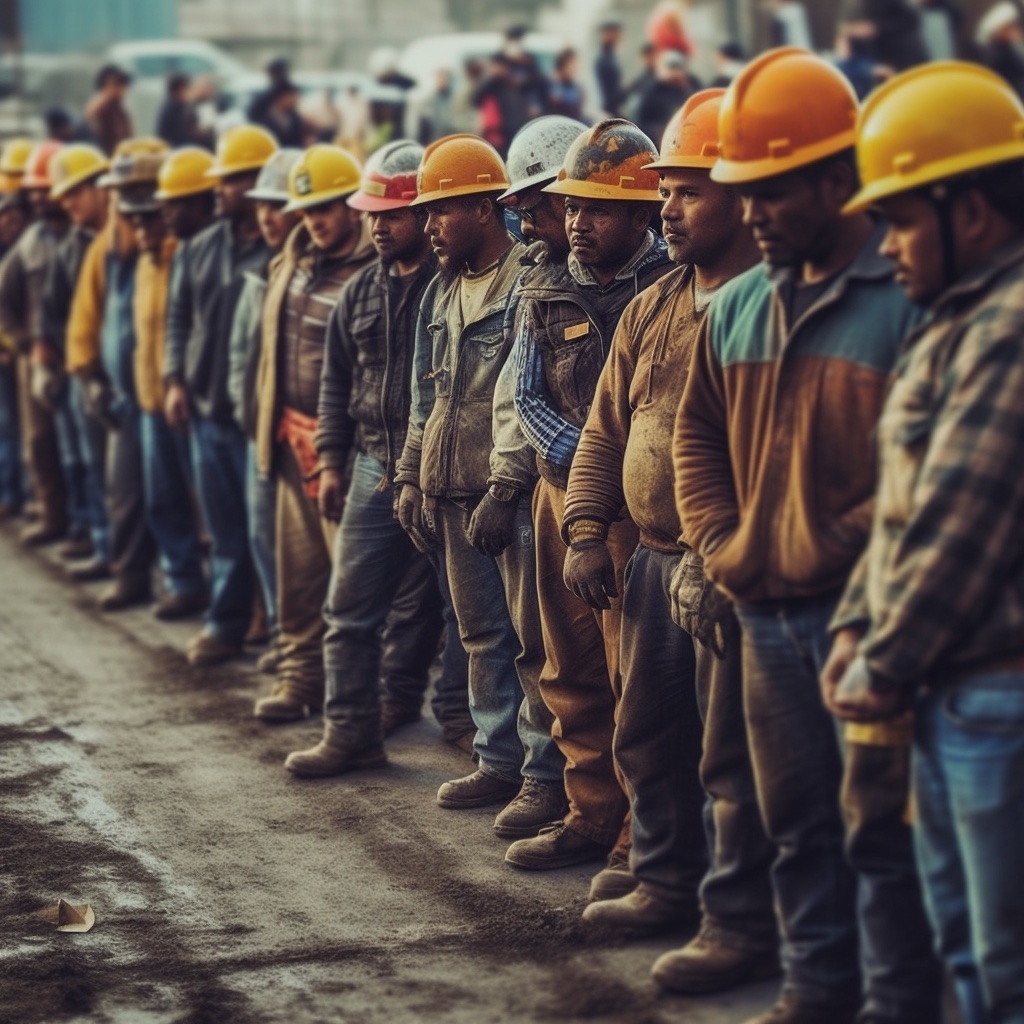The quest for safety in the workplace is a noble and necessary endeavour, particularly in high-risk industries such as construction, mining, and logistics. It is a delicate balance, however, between ensuring the highest safety standards and respecting the privacy of employees. This precarious equilibrium is perhaps nowhere more evident than in the contentious debate surrounding mandatory drug testing.
At the heart of this discourse are essential questions concerning the rights and responsibilities of both employees and employers. Does the critical need for safety in high-risk industries outweigh the privacy rights of employees? Where does the line between public safety and personal privacy fall, and who gets to make this call? These are complex issues that senior leaders in construction, mining, and logistics must grapple with, and there are no easy answers.
As it stands, mandatory drug testing has become increasingly prevalent in high-risk sectors. The rationale is clear: these industries can be dangerous, and the risk is magnified if employees are under the influence of substances that may impair their judgement or physical abilities. It's a straightforward concept in theory, but the practice of mandatory drug testing has ignited a significant debate that revolves around two pivot points—privacy and safety.

Mandatory Drug Testing in High-Risk Industries: A Necessary Measure?
Safety in high-risk industries is a paramount concern. The high levels of danger associated with sectors such as construction, mining, and logistics necessitate stringent safety measures. These industries are particularly susceptible to the harmful effects of substance abuse due to the high-stakes nature of the work. Drug use can significantly impair physical and cognitive abilities, leading to increased accident rates and posing severe safety threats.
Statistics paint a sobering picture. Alcohol and drug use have been linked to an alarming number of workplace incidents in these sectors, prompting the implementation of prevention strategies, with mandatory drug testing at the forefront.
But is this method effective in preventing accidents? And at what cost to employees' privacy rights? In addressing these questions, it's crucial to examine mandatory drug testing in real-world applications and their resultant impacts.

Mandatory Drug Testing in Action
The Construction Industry
Let's start with the construction industry. This sector has been an early adopter of mandatory drug testing due to its inherent high-risk, safety-sensitive nature. With documented high rates of alcohol and drug use among construction workers, there's been an escalating drive to develop effective drug surveillance and prevention strategies.
Companies with drug-testing programs saw a significant reduction in incident rates—about 51 percent within two years of implementation. Moreover, these companies experienced a considerable decrease in workers' compensation experience-rating modification factors (MODs), indicating a promising correlation between drug testing programs and savings.
But, while this approach seems to be beneficial in terms of enhancing safety and reducing costs, it raises an important question: is it justifiable to compromise on employees' privacy for the greater good of safety and cost-effectiveness? As we explore more case studies, we'll see this question is not just pertinent to the construction industry.
The Transportation Industry: A Federal Perspective
Moving from the construction sites to the roads, the transportation industry has not only embraced mandatory drug testing, but it has also been regulated by the federal government. Back in 1988, the Department of Transportation (DOT) laid out regulations mandating industry-wide testing of workers in several transportation sectors, a move that was upheld by the U.S. Supreme Court. This paved the way for mandatory drug testing in safety-sensitive positions, expanding the scope beyond post-accident situations.
Federal initiatives to enforce drug testing continued to strengthen when the U.S. Congress passed the Omnibus Transportation Employee Testing Act in 1991. This act commanded DOT agencies to implement drug and alcohol testing of safety-sensitive transportation employees, establishing a widespread regulation that regardless of the mode of transportation, DOT-required testing was essential. Compliance with these mandates is incumbent on the employer.
This regulation, known as 49 CFR Part 40, specifies how to conduct testing and how to return employees to safety-sensitive duties after they violate a DOT drug and alcohol regulation.
The regulations require commercial motor vehicle operators who need to maintain a commercial driver's license to be tested for alcohol and drugs. While employers can hire various service agents to collect specimens, conduct laboratory analyses, medically review lab results, and determine test outcomes, they cannot delegate their responsibility to comply with all applicable requirements and procedures. This means that employers are responsible for all actions of their employees, representatives, and agents, including service agents, in carrying out the requirements of the DOT agency regulations.
The transportation industry's firm stance on mandatory drug testing arises from the potential ramifications of drug-impaired driving. A mishap on the road can lead to catastrophic consequences affecting not just the driver but other innocent lives too. But, as with construction, questions persist: does the potential safety benefit outweigh the intrusion on privacy?
The Mining Industry: Balancing Safety and Privacy
Our exploration of mandatory drug testing wouldn't be complete without addressing one of the most dangerous industries in the world - mining. Individual states have pursued laws to this end. For example, In 2012, the West Virginia Legislature enacted HB 4531, a mine health and safety bill aimed at mitigating substance abuse among miners and fostering safety in the workplace. This law, in effect from January 1, 2013, mandates that all employers in the mining industry, whether they are operators, contractors, or subcontractors, implement both pre-employment and random drug testing.
This includes new hires, rehired employees, and those transferred into West Virginia operations from states without comparable drug testing legislation. The law also requires random drug testing of employees in safety-sensitive positions, which includes jobs related to the personal safety of employees. This random testing must be conducted through a scientifically valid method, ensuring each employee has an equal chance of selection.
This legislation also dictates the specifics of the required tests, which must screen for ten different substances and adhere to Department of Transportation standards, unless otherwise specified by the Office of Miner’s Health, Safety, and Training (OMHST). Alongside these testing requirements, the law also stipulates educational and reporting obligations. Employers must review drug testing policies with employees annually, with new hires, and whenever changes are made to the policy.
They must also send quarterly reports to OMHST detailing the number of tests conducted and the number of positive results. Despite these extensive requirements, the law lacks specifics in some areas, such as the handling of positive tests resulting from prescribed medications, and the relationship between these new regulations and the Americans with Disabilities Act. As such, employers in the mining industry are advised to stay updated to ensure ongoing compliance.

Case Study: Mandatory Drug Testing in Action in Mining
The case revolves around a West Virginia coal miner named Bobby Beavers who failed a mandatory, random workplace drug test after taking a legal, over-the-counter sleep aid. This sleep aid contained cannabidiol, or CBD, a component of marijuana that has gained popularity as a natural remedy for many common ailments. Beavers purchased the CBD product after a consultation with his local pharmacist who suggested it as a potential solution for his sleep problems. After using the CBD product, Beavers was subject to a random drug test at his workplace, Onyx Energy, where he subsequently tested positive for cannabinoids or THC.
According to the law passed in 2012, employers in the coal mining industry are required to test their certified employees for specific substances, including cannabinoids or THC1. Beavers' positive test result led to his surface coal miner certification being suspended.
The Mining Industry in Australia - Concerning but Improving
Drug use in Australia's mining industry has been a growing concern, with headlines frequently highlighting the problem. The issue is contextualised by Australia's general population's drug use, which is quite significant according to the United Nations 2014 World Drug Report. More than 10% of working-age Australians regularly use cannabis, and methamphetamine use tripled over five years to about 268,000 regular or dependent users. In the mining industry, methamphetamine, or "ice," is reportedly the drug of choice, with an alarming 38% of workers reportedly using it monthly, according to 2015 data from the Australian Industry Group. A study by Curtin University found that people involved in the mining sector in 2010 were eight percentage points more likely to use drugs for non-medical purposes compared to 2001.
In response to this issue, mining companies have been vigilant, routinely screening employees for a variety of substances, including amphetamines, methamphetamines, barbiturates, benzodiazepines, cannabinoids, cocaine, methadone, opiates, and morphine. However, more than 60% of mining companies do not test for "designer drugs," whose chemical compositions are continually altered to evade standard drug tests, according to a 2016 survey. Government and police efforts have also been intensified. For example, the Western Australian Police conducted Operation Redwater in 2016, where they searched 1,200 mine workers and their belongings for drugs at four Pilbara mine sites over four days. The operation found no trace of illicit drugs or paraphernalia, a result that both the police and mining companies considered encouraging.
As we delve deeper into the debate, it becomes evident that while the benefits of mandatory drug testing are significant, they don't negate the concerns over privacy invasion. The challenge, then, for senior leaders in these industries, is to strike a delicate balance between ensuring safety and respecting privacy.
Impact of Mandatory Drug Testing
This case brings to light several issues related to the implementation of mandatory drug testing.
a) Safety Records:
The case does not provide direct evidence regarding the impact on safety records. However, it's clear that the intent of mandatory drug testing is to maintain safety in the workplace.
b) Employee Morale:
Beavers' reaction to the suspension of his certification, where he testified that he began crying, suggests that such policies can have a significant emotional impact on employees, especially when legal substances can lead to positive test results1.
c) Legal Repercussions:
The case raised significant legal questions. Beavers appealed his suspension, and the Coal Mine Safety Board of Appeals sided with him, stating that the testing cannot distinguish whether the THC metabolite detected was from smoking marijuana or from consuming a CBD product. This decision was challenged by the West Virginia Office of Miners’ Health, Safety, and Training, which appealed to the state Supreme Court. The appeal argued that the law does not allow for the use of cannabidiol products as a defence and that THC from a CBD product is not exempt from testing1.
Understanding the Human Element: Real-life Experiences and Testimonials
While the statistics are compelling, it is important to reflect on the human element such as Bobby Beaver's story above. The voices of those impacted by these policies provide invaluable insight. Consider a miner, for instance, who shared his sense of relief that his coworkers were also drug-free. Having seen firsthand the dangers of drug use in the mining industry, he expressed gratitude for the drug-testing rule, which he felt had made his workplace safer.
On a similar note, a commercial driver reported feeling more focused and energised at work since he stopped using drugs, attributing his improved productivity to the implementation of the drug testing rule. For him, the rule had the effect of making him a safer and more efficient driver.
These testimonies offer a glimpse into the transformative effect of mandatory drug testing on individuals and their workplaces, revealing a deeper layer to the debate beyond numbers and regulations. While we must take privacy concerns into account, the personal experiences of these workers speak volumes about the potential benefits of drug testing, especially when it comes to fostering a safer and more productive work environment.
Toward a Balanced Approach
The debate over mandatory drug testing is complex, involving a careful balance of safety concerns and privacy rights. While mandatory testing can, and has, led to marked improvements in workplace safety and productivity, it also treads on sensitive ground regarding employee privacy.
In construction, transportation, and mining—industries where safety is of paramount importance—senior leaders must weigh these considerations carefully. It is crucial to create environments that prioritise safety and foster productivity while respecting individual privacy.
As we continue to discuss and debate this issue, the goal should be to develop policies that reflect a balanced approach, accommodating the vital need for safety, without encroaching on the rights and dignities of the individuals within these industries. The testimonies of workers and the reductions in workplace accidents paint a promising picture. Still, the path toward a universal solution that marries safety and privacy harmoniously continues to unfold.
Balancing safety and privacy is indeed a difficult task, but as the conversation advances, we remain hopeful that an acceptable middle ground can be reached—a ground that respects privacy while uncompromisingly safeguarding workplace safety.








